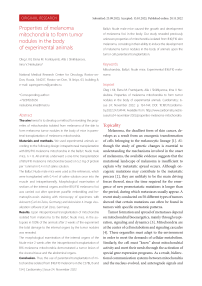Properties of melanoma mitochondria to form tumor nodules in the body of experimental animals
Автор: Kit Oleg I., Frantsiyants Elena M., Shikhlyarova Alla I., Neskubina Irina V.
Журнал: Cardiometry @cardiometry
Статья в выпуске: 24, 2022 года.
Бесплатный доступ
The aim hereof is to develop a method for revealing the properties of mitochondria isolated from melanoma of the skin to form melanoma tumor nodules in the body of mice in parenteral transplantation of melanoma mitochondria. Materials and methods. We used experimental animals according to the following design: intraperitoneal transplantation with B16/F10 melanoma mitochondria in the Balb/c Nude male mice, n = 8. All animals underwent a one-time transplantation of B16/F10 melanoma mitochondria based on 5.2 mg of protein per 1 animal in 0.4 ml of saline solution. The Balb/c Nude male mice were used as the references, which were transplanted with 0.4 ml of saline solution once into the muscle and intraperitoneally. Morphological examination of sections of the internal organs and the B16/F10 melanoma foci was carried out after specimen paraffin embedding and hematoxylin- eosin staining with microscopy of specimens with Axiovert (Carl 44 Zeiss, Germany) and Axiovision 4 image visualization software (Carl Zeiss, Germany). Results. Upon intraperitoneal transplantation of mitochondria isolated from melanoma to the Balb/c Nude mice, in the autopsies in 100% of the animals after 2 weeks of the experiment the total damage to the internal organs by the tumor nodules was revealed. The morphological examination of the internal organs of the Nude mice 2 weeks after the intraperitoneal transplantation of B16 melanoma mitochondria demonstrated a tumor lesion of the visceral tissue and the abdominal organs. Conclusion. Thus, the use of parenteral transplantation of mitochondria isolated from B16/F10 melanoma in the C57BL/6 and Balb/c Nude male mice caused the growth and development of melanoma foci in the body. Our study revealed previously unknown properties of mitochondria isolated from B16/F10 skin melanoma, consisting in their ability to induce the development of melanoma tumor nodules in the body of animals upon the tumor cell parenteral transplantation.
Mitochondria, balb/c nude mice, experimental b16/f10 melanoma
Короткий адрес: https://sciup.org/148326579
ID: 148326579 | DOI: 10.18137/cardiometry.2022.24.134144
Список литературы Properties of melanoma mitochondria to form tumor nodules in the body of experimental animals
- Shain AH, Bastian BC. From Melanocytes to Melanomas. Nat. Rev. Cancer. 2016; 16: 345–358. 10.1038/nrc.2016.37.
- Pogrebniak KL, Curtis C. Harnessing Tumor Evolution to Circumvent Resistance. Trends Genet. 2018; 34: 639–651. 10.1016/j.tig.2018.05.007.
- Nguyen B, et al. Genomic Characterization of Metastatic Patterns from Prospective Clinical Sequencing of 25,000 Patients. Cell. 2022; 185: 563–575. e11. 10.1016/j.cell.2022.01.003.
- Kumar S, Ashraf R, Aparna CK. Mitochondrial Dynamics Regulators: Implications for Therapeutic Intervention in Cancer. Cell Biol. Toxicol. 2021; 1: 3. 10.1007/s10565-021-09662-5.
- Makohon-Moore AP, et al. Limited Heterogeneity of Known Driver Gene Mutations Among the Metastases of Individual Patients with Pancreatic Cancer. Nat. Genet. 2017;49:358–366. 10.1038/ng.3764.
- Patel SA, Rodrigues P, Wesolowski L, Vanharanta S. Genomic Control of Metastasis. Br. J. Cancer. 2021; 124:3–12. 10.1038/s41416-020-01127-6.
- Soares CD, et al. Expression of Mitochondrial Dynamics Markers during Melanoma Progression: Comparative Study of Head and Neck Cutaneous and Mucosal Melanomas. J. Oral Pathol. Med. 2019; 48:373–381. 10.1111/jop.12855.
- Zhang X, et al. Redox Signals at the ER–mitochondria Interface Control Melanoma Progression. EMBO J. 2019;38. 10.15252/embj.2018100871.
- Denisenko TV, Gorbunova AS, Zhivotovsky B. Mitochondrial Involvement in Migration, Invasion and Metastasis. Front Cell Dev Biol. 2019;7:355. doi: 10.3389/fcell.2019.00355. PMID: 31921862; PMCID: PMC6932960.
- Kitania T, et al. Direct Human Mitochondrial Transfer: A Novel Concept Based on the Endosymbiotic Theory. Transplantation Proceedings. 2014; 46 (4): 1233-1236.
- Katrangi E, et al. Xenogenic transfer of isolated murine mitochondria into human rho0 cells can improve respiratory function. Rejuvenation Res. 2007; 10: 561–570. doi: 10.1089/rej.2007.0575.
- Park A, et al. Mitochondrial Transplantation as a Novel Therapeutic Strategy for Mitochondrial Diseases. Int J Mol Sci. 2021; 22(9): 4793. doi: 10.3390/ijms22094793.
- Feng Yu, et al. Human bone marrow mesenchymal stem cells rescue chemotherapy-stressed endothelial cells by transporting mitochondria through tunneling nanotubes. Stem cells and development. 2019; 28(10): 674-682. doi: 10.1089/scd.2018.0248.
- Yang F, et al. Tunneling Nanotube-Mediated Mitochondrial Transfer Rescues Nucleus Pulposus Cells from Mitochondrial Dysfunction and Apoptosis. Oxid Med Cell Longev. 2022; 4: 3613319. doi: 10.1155/2022/3613319.
- Nahacka Z, Novak J, Zobalova R, Neuzil J. Miro proteins and their role in mitochondrial transfer in cancer and beyond. Frontiers in cell and developmental biology. 2022; 10: 937753. doi:10.3389/fcell.2022.937753.
- Wang J, et al. Stem cell-derived mitochondria transplantation: a novel strategy and the challenges for the treatment of tissue injury. Stem Cell Res Ther. 2018; 9: 106. doi: 10.1186/s13287-018-0832-2.
- Hough KP, et al. Exosomal transfer of mitochondria from airway myeloid-derived regulatory cells to T cells. Redox biology. 2018; 18: 54–64. doi: 10.1016/j.redox.2018.06.009.
- Mccully JD, et al. Transplantation of autologously derived mitochondria protects the heart from ischemia-reperfusion injury. Am J Physiol. 2013; 304: H966–H982. doi: 10.1152/ajpcell.00261.2012.
- Bertero E, Maack C, O’Rourke B. Mitochondrial transplantation in humans: “magical” cure or cause for concern? J Clin Investig. 2018; 128: 5191–5194. doi: 10.1172/JCI124944.
- Masuzawa A, et al. Transplantation of autologously derived mitochondria protects the heart from ischemia-reperfusion injury. Am J Physiol. 2013; 304: H966–H982. doi: 10.1152/ajpcell.00261.2012.
- Egorova MV, Afanasiev SA. Isolation of mitochondria from cells and tissues of animals and humans: Modern methodological techniques. Siberian Medical Journal. 2011; 26(1-1): 22-28. [in Russian]
- Gureev AP, Kokina AV, Syromyatnikova MYu, Popov VN. Optimization of methods for isolating mitochondria from different mouse tissues. Bulletin of VSU, series: chemistry, biology, pharmacy. 2015; 4: 61-65. [in Russian]


